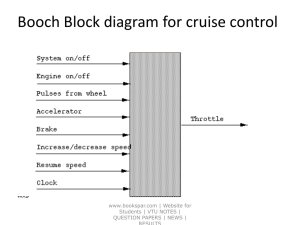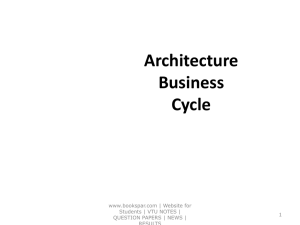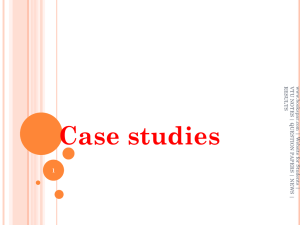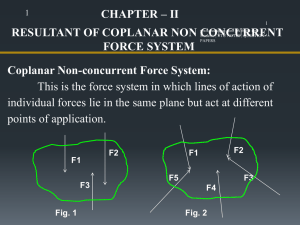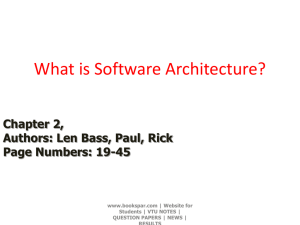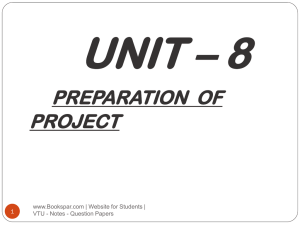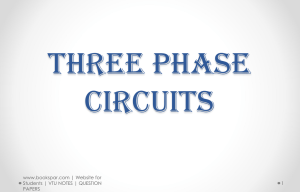Unit-1-Embedded-Systems
advertisement
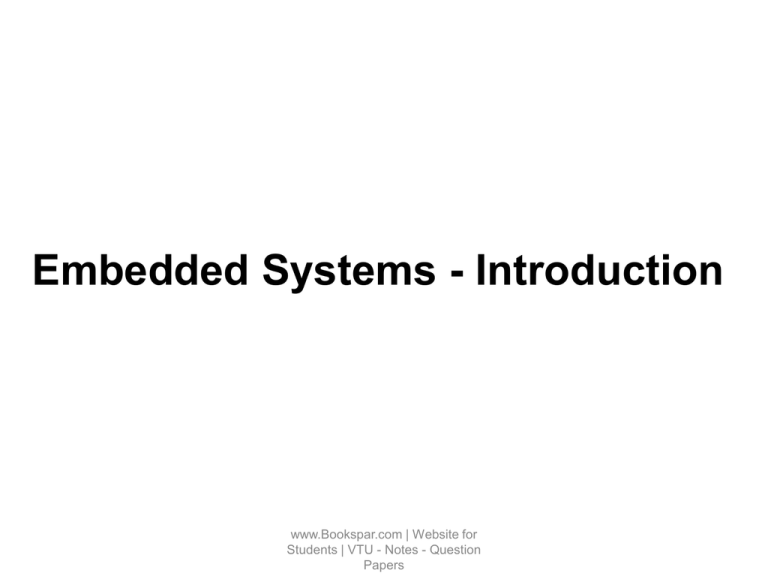
Embedded Systems - Introduction www.Bookspar.com | Website for Students | VTU - Notes - Question Papers System Definition A way of working, organizing or performing one or many tasks according to a fixed set of rules, program or plan. www.Bookspar.com | Website for Students | VTU - Notes - Question Papers System Definition An arrangement in which all units assemble and work together according to a program or plan. www.Bookspar.com | Website for Students | VTU - Notes - Question Papers Examples of Systems Time display system – A watch Automatic cloth washing system – A washing machine www.Bookspar.com | Website for Students | VTU - Notes - Question Papers Embedded System Definition: 1. “An embedded system is a system that has software embedded into computer-hardware, which makes a system dedicated for an application (s) or specific part of an application or product or part of a larger system.” www.Bookspar.com | Website for Students | VTU - Notes - Question Papers Contd.. 2. “An embedded system is one that has a dedicated purpose software embedded in a computer hardware.” www.Bookspar.com | Website for Students | VTU - Notes - Question Papers Contd.. 3. “It is any device that includes programmable computer but is not itself intended to be a general purpose computer.” – Wayne Wolf, Ref: 61 www.Bookspar.com | Website for Students | VTU - Notes - Question Papers 4. “Embedded Systems are the electronic systems that contain a microprocessor or a microcontroller, but we do not think of them as computers– the computer is hidden or embedded in the system.” – Todd D. Morton, Ref: 38 www.Bookspar.com | Website for Students | VTU - Notes - Question Papers www.Bookspar.com | Website for Students | VTU - Notes - Question Papers Let’s consider a Computer A computer is a system that has the following or more components. • A microprocessor • A large memory comprising the following two kinds: (a) Primary memory (semiconductor memories - RAM, ROM and fast accessible caches) www.Bookspar.com | Website for Students | VTU - Notes - Question Papers Contd.. Computer (b) Secondary memory [(magnetic memory located in hard disks, diskettes and cartridge tapes, optical memory in CD-ROM or memory stick (in mobile computer)] using which different user programs can load into the primary memory and can be run. • I/O units such as touch screen, modem, fax cum modem etc. www.Bookspar.com | Website for Students | VTU - Notes - Question Papers Contd.. • Input units such as keyboard, mouse, digitizer, scanner, etc. • Output units like LCD screen, video monitor, printer, etc. • Networking units like Ethernet card, frontend processor-based server, bus drivers, etc. www.Bookspar.com | Website for Students | VTU - Notes - Question Papers Contd.. •Operating system (OS). • General purpose user interfaces and application software, mostly in secondary memory www.Bookspar.com | Website for Students | VTU - Notes - Question Papers Three main embedded components in an Embedded System 1. Embeds hardware to give computer like functionalities. 2.Embeds main application software generally into flash or ROM and the application software performs concurrently the number of tasks. www.Bookspar.com | Website for Students | VTU - Notes - Question Papers 3. Embeds a real time operating system ( RTOS), which supervises the application software tasks running on the hardware and organizes the accesses to system resources according to priorities and timing constraints of tasks in the system. www.Bookspar.com | Website for Students | VTU - Notes - Question Papers Real Time Operating System(RTOS) An RTOS is an OS for response time controlled and event controlled processes. Software for a large number of small-scale embedded systems use no RTOS and these functions are incorporated into the application software. www.Bookspar.com | Website for Students | VTU - Notes - Question Papers • Enables execution of concurrent processes or threads or tasks • Provides a mechanism to let the processor run each process as per scheduling and to do context-switch between the various processes (threads or tasks) www.Bookspar.com | Website for Students | VTU - Notes - Question Papers • RTOS sets the rules during execution RTOS is necessary for large-scale embedded systems. It is essential when • I/O management with devices, files and mail-boxes becomes simple using a RTOS. • scheduling of multiple processes and devices www.Bookspar.com | Website for Students | VTU - Notes - Question Papers RTOS v/s General Purpose OS 1. Determinism 2. Task Scheduling 3. Preemptive kernel 4. Priority Inversion 5. Usage www.Bookspar.com | Website for Students | VTU - Notes - Question Papers Sophisticated Embedded System Characteristics (1) Dedicated functions (2) Dedicated complex algorithms (3)Dedicated (GUIs) and other user interfaces for the application www.Bookspar.com | Website for Students | VTU - Notes - Question Papers (4) Real time operations— Defines the ways in which the system works, reacts to the events and interrupts, schedules the system functioning in real time and executes by following a plan to control the latencies and to meet the deadlines. www.Bookspar.com | Website for Students | VTU - Notes - Question Papers Contd.. (5) Multi-rate operations -Different operations may take place at distinct rates. For example, the audio, video, network data or stream and events have the different rates and time constraints to finish associated processes.. www.Bookspar.com | Website for Students | VTU - Notes - Question Papers Constraints of an Embedded System Design • Available system-memory • Available processor speed • Limited power dissipation when running the system continuously in cycles of the system start, wait for event, wake-up and run, sleep and stop. www.Bookspar.com | Website for Students | VTU - Notes - Question Papers • Performance • power • size • non-recurring design manufacturing costs www.Bookspar.com | Website for Students | VTU - Notes - Question Papers cost, and PROCESSOR IN EMBEDDED SYSTEM •Processor is the heart of embedded system • Processor has two essential units: Control Unit(CU) Execution Unit(EU) www.Bookspar.com | Website for Students | VTU - Notes - Question Papers • Program Flow and data path (CU) Control Unit—includes a fetch unit for fetching instructions from the memory. www.Bookspar.com | Website for Students | VTU - Notes - Question Papers • Execution Unit (EU) —includes circuits for arithmetic and logical unit (ALU), and for instructions for a program control task, say, data transfer instructions, halt, interrupt, or jump to another set of instructions or call to another routine or sleep or reset. www.Bookspar.com | Website for Students | VTU - Notes - Question Papers A Processor is in the form of an IC or it could be in core form in an Application Specific Integrated Circuit (ASIC) or System on Chip (SoC). An embedded processor chip or core can be one of the following: www.Bookspar.com | Website for Students | VTU - Notes - Question Papers 1. General Purpose Processor (GPP) : instruction set designed not specific to the applications. example: Microprocessor www.Bookspar.com | Website for Students | VTU - Notes - Question Papers • A Microprocessor is a single VLSI chip that has a CPU and has some other units such as caches, pipelining and super scaling units. • is an essential part of a computing system. Intel 80x86 family, ARM, 68HCxxx family. www.Bookspar.com | Website for Students | VTU - Notes - Question Papers 2. Application Specific Instruction-set Processor (ASIP): is a processor with instruction set designed for specific applications on a VLSI chip. Examples: micro controller embedded micro controller DSP and media processor Network processor IO processor or domain-specific programmable processor www.Bookspar.com | Website for Students | VTU - Notes - Question Papers • A Microcontroller is an integrated chip (IC) that has a processor, memory and several other hardware units in it such as timers, watchdog timer, interrupt controller, ADC or PWM . • is an essential component of a control or communication circuit. 8051, 8051 MX, 68HC11xx, PIC18 www.Bookspar.com | Website for Students | VTU - Notes - Question Papers Various functional circuits in a microcontroller chip: www.Bookspar.com | Website for Students | VTU - Notes - Question Papers Commonly used exemplary microcontrollers in small scale embedded Systems www.Bookspar.com | Website for Students | VTU - Notes - Question Papers www.Bookspar.com | Website for Students | VTU - Notes - Question Papers www.Bookspar.com | Website for Students | VTU - Notes - Question Papers 3. Single Purpose Processors or additional processors: Examples: • Coprocessors: used for graphic processing, floating point processing, encrypting, deciphering, discrete cosine transformation and inverse transformation on TCP/IP protocol stacking and networking connecting functions. www.Bookspar.com | Website for Students | VTU - Notes - Question Papers • Accelerator: Java codes accelerator • Controllers: for peripherals, memory access and buses www.Bookspar.com | Website for Students | VTU - Notes - Question Papers direct 4. GPP or ASIP cores integrated into either an ASIC or VLSI circuit or a Field Programmable Gate Array (FPGA) core integrated with processor units in a VLSI chip. 5. Application Specific system Processor (ASSP) 6.Multi core processors or multi processors. www.Bookspar.com | Website for Students | VTU - Notes - Question Papers www.Bookspar.com | Website for Students | VTU - Notes - Question Papers www.Bookspar.com | Website for Students | VTU - Notes - Question Papers Embedded hardware units and Devices in a system 1. Power source • • A power supply source or charge pump is essential in every system. The systems which do not have power supply of their own are powered by the use of charge pumps or they connect to external power supply. www.Bookspar.com | Website for Students | VTU - Notes - Question Papers 2. Clock Oscillator circuit and Clocking units: • the clock controls the time for executing an instruction. • also controls the various clocking requirements of CPU, of system timers, CPU machine cycles. • A processor needs a clock oscillator circuit to establish a reference frequency used for timing purposes. www.Bookspar.com | Website for Students | VTU - Notes - Question Papers 3. System Clock(RTC): timers and Real-Time • to schedule the various tasks and for real time programming , an RTC or system clock is needed. • A timer circuit is configured as system clock , which ticks and generates interrupts periodically. www.Bookspar.com | Website for Students | VTU - Notes - Question Papers 4. Reset circuit , Power-up Reset and Watchdog timer Reset : • Reset circuit can change the Program Counter (PC) to a power-up default value. • A program that is reset and runs on a powerup can be one of the following: i) system program that executes from the beginning. ii) A system boot-up program iii) A system initialization program www.Bookspar.com | Website for Students | VTU - Notes - Question Papers Reset: Processor begins the processing instructions from a starting address. of The reset circuit can be activated by any one of the following: 1. software instruction 2. time-out by a programmable timer known as watchdog timer. 3. a clock monitor detecting a slow down below certain frequencies. www.Bookspar.com | Website for Students | VTU - Notes - Question Papers Watchdog Timer: A timing device that resets the system after a predefined timeout. Helps in rescuing the system if a fault develops. www.Bookspar.com | Website for Students | VTU - Notes - Question Papers Memory: a. Functions Assigned to the ROM or EPROM or Flash 1. Storing 'Application' program from where the processor fetches the instruction codes. 2. Storing codes for system booting, initializing, Initial input data and Strings. www.Bookspar.com | Website for Students | VTU - Notes - Question Papers 3. Storing Codes for RTOS. 4. Storing Pointers (addresses) of various service routines. www.Bookspar.com | Website for Students | VTU - Notes - Question Papers | RESULTS |NEWS | FORUM b. Functions Assigned to the Internal, External and Buffer RAM: 1. Storing the variables during program run, 2. Storing the stacks, 3. Storing input or output buffers for example, for speech or image . www.Bookspar.com | Website for Students | VTU - Notes - Question Papers c. Functions Assigned to the EEPROM or Flash : • Storing non-volatile results of processing www.Bookspar.com | Website for Students | VTU - Notes - Question Papers d. Functions Assigned to the Caches: 1. Storing copies of the instructions, data and branch-transfer instructions in advance from external memories and 2. Storing temporarily the results in write back caches during fast processing www.Bookspar.com | Website for Students | VTU - Notes - Question Papers e. Functions Assigned to Memory Stick: It stores high definition video, images, songs, Or speeches after a suitable format compression And stores large persistent data. in digital camera, mobile computing system www.Bookspar.com | Website for Students | VTU - Notes - Question Papers
